



Viverridae is a familyofmammals in the order Carnivora, composed mainly of the civets and genets. A member of this family is called a viverrid. They are widespread primarily throughout Africa, India, and southeast Asia, and are found primarily in forests, shrublands, and grasslands, though some species can be found in savannas or wetlands. Most viverrids are 40 to 65 cm (16 to 26 in) long, plus a 35 to 60 cm (14 to 24 in) tail, though the West African oyan can be as small as 30 cm (12 in) plus a 35 cm (14 in) tail, and some binturongs can be up to 96 cm (38 in) plus a 89 cm (35 in) tail. Most species do not have population estimates, though three viverrids are classified as endangered, and one, the Malabar large-spotted civet, is classified as critically endangered with a population size of around 200. No viverrid species have been domesticated.
The thirty-three species of Viverridae are split into fourteen genera within four subfamilies: the three civet subfamilies Viverrinae, Hemigalinae, and Paradoxurinae, and the genet subfamily Genettinae. A fifth subfamily, Prionodontinae, was previously included in Viverridae, while the species in Genettinae were considered part of Viverrinae, but more recent genetic evidence resulted in the consensus to separate Prionodontinae into its own family and split out Genettinae into its own subfamily. Extinct species have also been placed into Viverrinae, as well as the extinct subfamily Lophocyoninae, though most extinct species have not been categorized into a subfamily. Nearly twenty extinct Viverridae species have been discovered, though due to ongoing research and discoveries the exact number and categorization is not fixed.
| Conservation status | |
|---|---|
| EX | Extinct (0 species) |
| EW | Extinct in the wild (0 species) |
| CR | Critically Endangered (1 species) |
| EN | Endangered (3 species) |
| VU | Vulnerable (6 species) |
| NT | Near threatened (3 species) |
| LC | Least concern (18 species) |
| Other categories | |
| DD | Data deficient (2 species) |
| NE | Not evaluated (0 species) |
Conservation status codes listed follow the International Union for Conservation of Nature (IUCN) Red List of Threatened Species. Range maps are provided wherever possible; if a range map is not available, a description of the viverrid's range is provided. Ranges are based on the IUCN Red List for that species unless otherwise noted.
The family Viverridae consists of 33 extant species belonging to 14 genera in 4 subfamilies and divided into dozens of extant subspecies. This does not include hybrid species or extinct prehistoric species.
The following classification is based on the taxonomy described by Mammal Species of the World (2005), with augmentation by generally accepted proposals made since using molecular phylogenetic analysis. This includes the promotion of the Prionodontinae subfamily into its own family, and the moving of the Poiana and Genetta genera out of the Viverrinae subfamily into their own Genettinae subfamily. There are several additional proposals which are disputed, such as splitting the golden palm civet into three species or adding three additional species to Genetta, which are not included here.[1][2]
| Common name | Scientific name and subspecies | Range | Size and ecology | IUCN status and estimated population |
|---|---|---|---|---|
| Abyssinian genet | G. abyssinica (Rüppell, 1836) |
Northeast Africa
|
Size: 40–43 cm (16–17 in) long, plus 38–41 cm (15–16 in) tail[3] Habitat: Forest, shrubland, and grassland[4] Diet: Primarily eats rodents, birds, and seeds, as well as insects and fruit[4][5] |
DD
|
| Angolan genet | G. angolensis Bocage, 1882 |
Scattered south-central Africa
|
Size: 44–48 cm (17–19 in) long, plus 38–43 cm (15–17 in) tail[3] Habitat: Savanna[6] Diet: Believed to primarily eat insects, as well as fruit[6][5] |
LC
|
| Aquatic genet | G. piscivora (Allen, 1919) |
Central Africa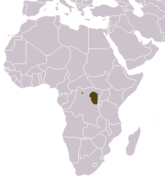
|
Size: 44–50 cm (17–20 in) long, plus 34–42 cm (13–17 in) tail[5] Habitat: Forest and inland wetlands[7] Diet: Primarily eats fish[7] |
NT
|
| Bourlon's genet
|
G. bourloni Gaubert, 2003 |
West Africa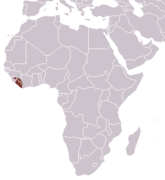
|
Size: 49–50 cm (19–20 in) long, plus 40–42 cm (16–17 in) tail[5] Habitat: Forest[8] Diet: Unknown[8][5] |
VU
|
| Cape genet | G. tigrina (Schreber, 1776) Two subspecies
|
South Africa | Size: 42–58 cm (17–23 in) long, plus 38–46 cm (15–18 in) tail[5] Habitat: Forest, shrubland, and grassland[9] Diet: Omnivorous; primarily eats insects and small mammals[9][5] |
LC
|
| Common genet | G. genetta (Linnaeus, 1758) Five subspecies
|
Bands of north, central, and south Africa and parts of Arabian peninsula (green), introduced in southwest Europe (red), formerly introduced in Nile river area (black)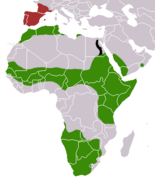
|
Size: 46–52 cm (18–20 in) long, plus 42–52 cm (17–20 in) tail[3] Habitat: Forest, savanna, shrubland, and rocky areas[10] Diet: Primarily eats small mammals, as well as birds, other small vertebrates, insects, and fruit[10] |
LC
|
| Crested servaline genet | G. cristata Hayman, 1940 |
Northwest Africa
|
Size: 49–63 cm (19–25 in) long, plus 43 cm (17 in) tail[3] Habitat: Forest[11] Diet: Primarily eats insects, as well as small mammals, reptiles, and vegetables[11][5] |
VU
|
| Giant forest genet | G. victoriae Thomas, 1902 |
Central Africa
|
Size: 55–60 cm (22–24 in) long, plus 41–49 cm (16–19 in) tail[5] Habitat: Forest[12] Diet: Primarily eats fruit, as well as rodents, birds, and insects[12][5] |
LC
|
| Hausa genet | G. thierryi Matschie, 1902 |
West Africa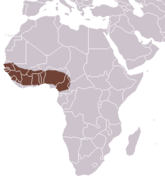
|
Size: 44–45 cm (17–18 in) long, plus 40–43 cm (16–17 in) tail[3] Habitat: Forest, savanna, and shrubland[13] Diet: Unknown[13][5] |
LC
|
| Johnston's genet
|
G. johnstoni Pocock, 1908 |
Northwest Africa
|
Size: 47–52 cm (19–20 in) long, plus 46–50 cm (18–20 in) tail[5] Habitat: Forest, savanna, and shrubland[14] Diet: Believed to primarily eat insects[14][5] |
NT
|
| King genet
|
G. poensis Waterhouse, 1838 |
Scattered parts of west Africa
|
Size: 42–68 cm (17–27 in) long, plus 35–47 cm (14–19 in) tail[5] Habitat: Forest[15] Diet: Unknown; believed to eat mammals and fruit[15] |
DD
|
| Pardine genet | G. pardina Geoffroy, 1832 |
Northwest Africa
|
Size: 41–56 cm (16–22 in) long, plus 39–45 cm (15–18 in) tail[5] Habitat: Forest, savanna, and shrubland[16] Diet: Primarily eats rodents, as well as insects, fruit, birds, and other small mammals[16][5] |
LC
|
| Rusty-spotted genet | G. maculata (Gray, 1830) |
Central and south Africa
|
Size: 41–53 cm (16–21 in) long, plus 39–54 cm (15–21 in) tail[3] Habitat: Forest, savanna, and shrubland[17] Diet: Primarily eats invertebrates, fish, amphibians, reptiles, small birds, eggs, and small mammals, as well as fruit, seeds, and berries[17][5] |
LC
|
| Servaline genet | G. servalina Pucheran, 1855 Five subspecies
|
Central africa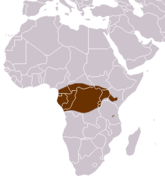
|
Size: 44–51 cm (17–20 in) long, plus 36–49 cm (14–19 in) tail[5] Habitat: Forest and shrubland[18] Diet: Primarily eats small mammals and insects, as well as snakes, birds, and fruit[18][5] |
LC
|
| Common name | Scientific name and subspecies | Range | Size and ecology | IUCN status and estimated population |
|---|---|---|---|---|
| Central African oyan | P. richardsonii (Thomson, 1842) Two subspecies
|
Central Africa
|
Size: 33–38 cm (13–15 in) long, plus 35–40 cm (14–16 in) tail[19] Habitat: Forest[20] Diet: Believed to eat small vertebrates and invertebrates[20][3] |
LC
|
| West African oyan
|
P. leightoni Pocock, 1908 |
West Africa
|
Size: 30–38 cm (12–15 in) long, plus 35–40 cm (14–16 in) tail[3] Habitat: Forest[21] Diet: Believed to eat small vertebrates and invertebrates[21][3] |
VU
|
| Common name | Scientific name and subspecies | Range | Size and ecology | IUCN status and estimated population |
|---|---|---|---|---|
| Owston's palm civet | C. owstoni Thomas, 1912 |
Southeast Asia around Vietnam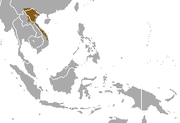
|
Size: 51–63 cm (20–25 in) long, plus 38–48 cm (15–19 in) tail[22] Habitat: Forest and shrubland[23] Diet: Believed to primarily eat earthworms and other invertebrates[23] |
EN
|
| Common name | Scientific name and subspecies | Range | Size and ecology | IUCN status and estimated population |
|---|---|---|---|---|
| Otter civet | C. bennettii (Gray, 1837) Two subspecies
|
Southeast Asia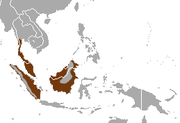
|
Size: 57–68 cm (22–27 in) long, plus 12–21 cm (5–8 in) tail[22] Habitat: Forest and inland wetlands[24] Diet: Primarily eats fish, crabs, molluscs, small mammals, and birds[24] |
EN
|
| Common name | Scientific name and subspecies | Range | Size and ecology | IUCN status and estimated population |
|---|---|---|---|---|
| Hose's palm civet | D. hosei Thomas, 1892 |
Borneo in Southeast Asia
|
Size: 47–54 cm (19–21 in) long, plus 29–34 cm (11–13 in) tail[25] Habitat: Forest[26] Diet: Believed to primarily eat small fish, shrimp, crabs, and frogs as well as insects[26] |
VU
|
| Common name | Scientific name and subspecies | Range | Size and ecology | IUCN status and estimated population |
|---|---|---|---|---|
| Banded palm civet | H. derbyanus (Gray, 1837) Four subspecies
|
Southeast Asia
|
Size: 45–56 cm (18–22 in) long, plus 25–36 cm (10–14 in) tail[22] Habitat: Forest[27] Diet: Primarily eats insects[27] |
NT
|
| Common name | Scientific name and subspecies | Range | Size and ecology | IUCN status and estimated population |
|---|---|---|---|---|
| Binturong | A. binturong (Raffles, 1821) Six subspecies
|
Southeast Asia
|
Size: 61–96 cm (24–38 in) long, plus 56–89 cm (22–35 in) tail[28] Habitat: Forest[29] Diet: Primarily eats fruit[29] |
VU
|
| Common name | Scientific name and subspecies | Range | Size and ecology | IUCN status and estimated population |
|---|---|---|---|---|
| Small-toothed palm civet | A. trivirgata (Gray, 1832) Fourteen subspecies
|
Southeast Asia
|
Size: 44–60 cm (17–24 in) long, plus 48–66 cm (19–26 in) tail[30] Habitat: Forest[31] Diet: Omnivorous; primarily eats fruit[31] |
LC
|
| Common name | Scientific name and subspecies | Range | Size and ecology | IUCN status and estimated population |
|---|---|---|---|---|
| Sulawesi palm civet | M. musschenbroekii (Schlegel, 1877) |
Sulawesi island in Southeast Asia
|
Size: 65–72 cm (26–28 in) long, plus 44–54 cm (17–21 in) tail[3] Habitat: Forest, shrubland, and grassland[32] Diet: Primarily eats rodents and palm fruit, as well as other small mammals, birds, fruit, and grass[32] |
VU
|
| Common name | Scientific name and subspecies | Range | Size and ecology | IUCN status and estimated population |
|---|---|---|---|---|
| Masked palm civet | P. larvata (H. Smith, 1827) Sixteen subspecies
|
East and southeast Asia
|
Size: 50–76 cm (20–30 in) long, plus 50–64 cm (20–25 in) tail[33] Habitat: Forest and shrubland[34] Diet: Omnivorous; primarily eats fruit[34] |
LC
|
| Common name | Scientific name and subspecies | Range | Size and ecology | IUCN status and estimated population |
|---|---|---|---|---|
| Asian palm civet | P. hermaphroditus (Pallas, 1777) 30 subspecies
|
South and southeast Asia (green), introduced (red)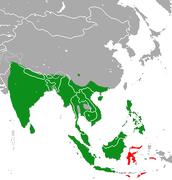
|
Size: 47–57 cm (19–22 in) long, plus 47–56 cm (19–22 in) tail[35] Habitat: Forest, shrubland, and grassland[36] Diet: Primarily eats rats and fruit, as well as insects and molluscs[36] |
LC
|
| Brown palm civet | P. jerdoni Blanford, 1885 Two subspecies
|
Southwest India
|
Size: 43–62 cm (17–24 in) long, plus 38–53 cm (15–21 in) tail[37] Habitat: Forest[38] Diet: Primarily eats fruit, as well as birds, rodents, and insects[38] |
LC
|
| Golden palm civet | P. zeylonensis (Schreber, 1778) |
Sri Lanka
|
Size: 50–58 cm (20–23 in) long, plus 43–53 cm (17–21 in) tail[3] Habitat: Forest and shrubland[39] Diet: Primarily eats berries, fruits, and invertebrates, as well as small vertebrates[39] |
LC
|
| Common name | Scientific name and subspecies | Range | Size and ecology | IUCN status and estimated population |
|---|---|---|---|---|
| African civet | C. civetta (Schreber, 1776) Six subspecies
|
Central and south Africa
|
Size: 60–92 cm (24–36 in) long, plus 43–61 cm (17–24 in) tail[40] Habitat: Forest, savanna, shrubland, and inland wetlands[41] Diet: Omnivorous; primarily eats fruit[41] |
LC
|
| Common name | Scientific name and subspecies | Range | Size and ecology | IUCN status and estimated population |
|---|---|---|---|---|
| Large-spotted civet | V. megaspila Blyth, 1862 |
Southeast Asia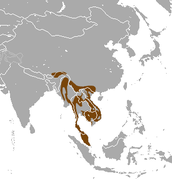
|
Size: 77–90 cm (30–35 in) long, plus 32–40 cm (13–16 in) tail[35] Habitat: Forest, shrubland, and inland wetlands[42] Diet: Primarily eats birds, frogs, snakes, small mammals, eggs, crabs, fish, fruit, and roots[35][42] |
EN
|
| Large Indian civet | V. zibetha Linnaeus, 1758 Five subspecies
|
Southeast Asia
|
Size: 50–95 cm (20–37 in) long, plus 38–59 cm (15–23 in) tail[35] Habitat: Forest and shrubland[43] Diet: Primarily eats fish, birds, lizards, frogs, insects, arthropods, and crabs, as well as poultry and rubbish[43] |
LC
|
| Malabar large-spotted civet | V. civettina Blyth, 1862 |
Southwest India
|
Size: 76 cm (30 in) long, plus 33 cm (13 in) tail[44] Habitat: Forest and inland wetlands[45] Diet: Unknown[45] |
CR
|
| Malayan civet | V. tangalunga Gray, 1832 Two subspecies
|
Southeast Asia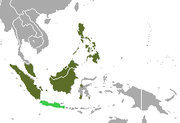
|
Size: 58–95 cm (23–37 in) long, plus 30–49 cm (12–19 in) tail[46] Habitat: Forest and shrubland[47] Diet: Omnivorous[47] |
LC
|
| Common name | Scientific name and subspecies | Range | Size and ecology | IUCN status and estimated population |
|---|---|---|---|---|
| Small Indian civet | V. indica (Desmarest, 1804) Twelve subspecies
|
South and southeast Asia
|
Size: 45–63 cm (18–25 in) long, plus 30–43 cm (12–17 in) tail[48] Habitat: Forest, savanna, shrubland, grassland, and inland wetlands[49] Diet: Primarily eats rodents, birds, snakes, fruit, roots, carrion, and insects[49] |
LC
|
|
Lists of mammal species
| |||||||||||||||
|---|---|---|---|---|---|---|---|---|---|---|---|---|---|---|---|
| By class |
| ||||||||||||||
| By subclass or infraclass |
| ||||||||||||||
| By order |
| ||||||||||||||
| By suborder or family |
| ||||||||||||||
| By species |
| ||||||||||||||